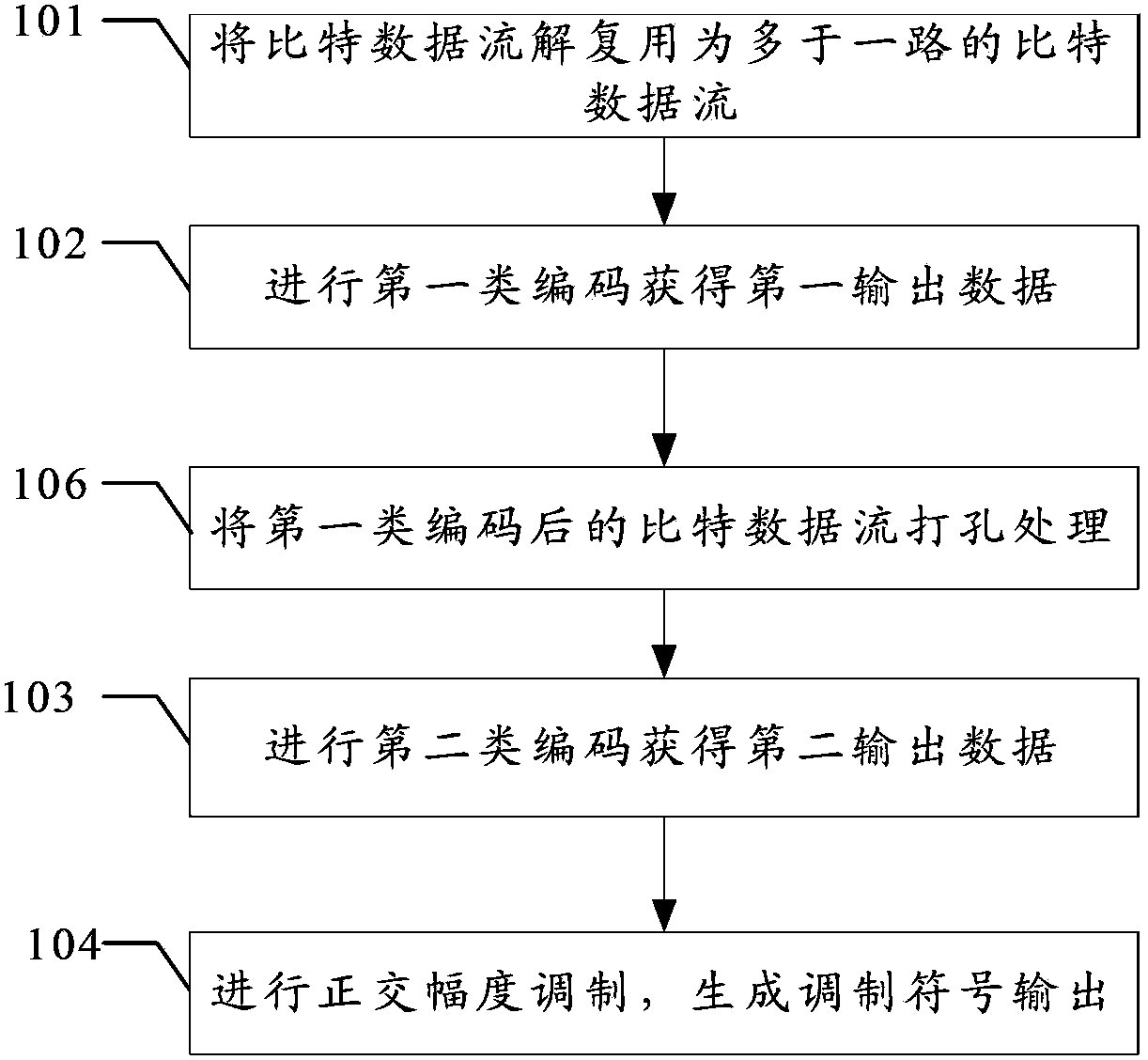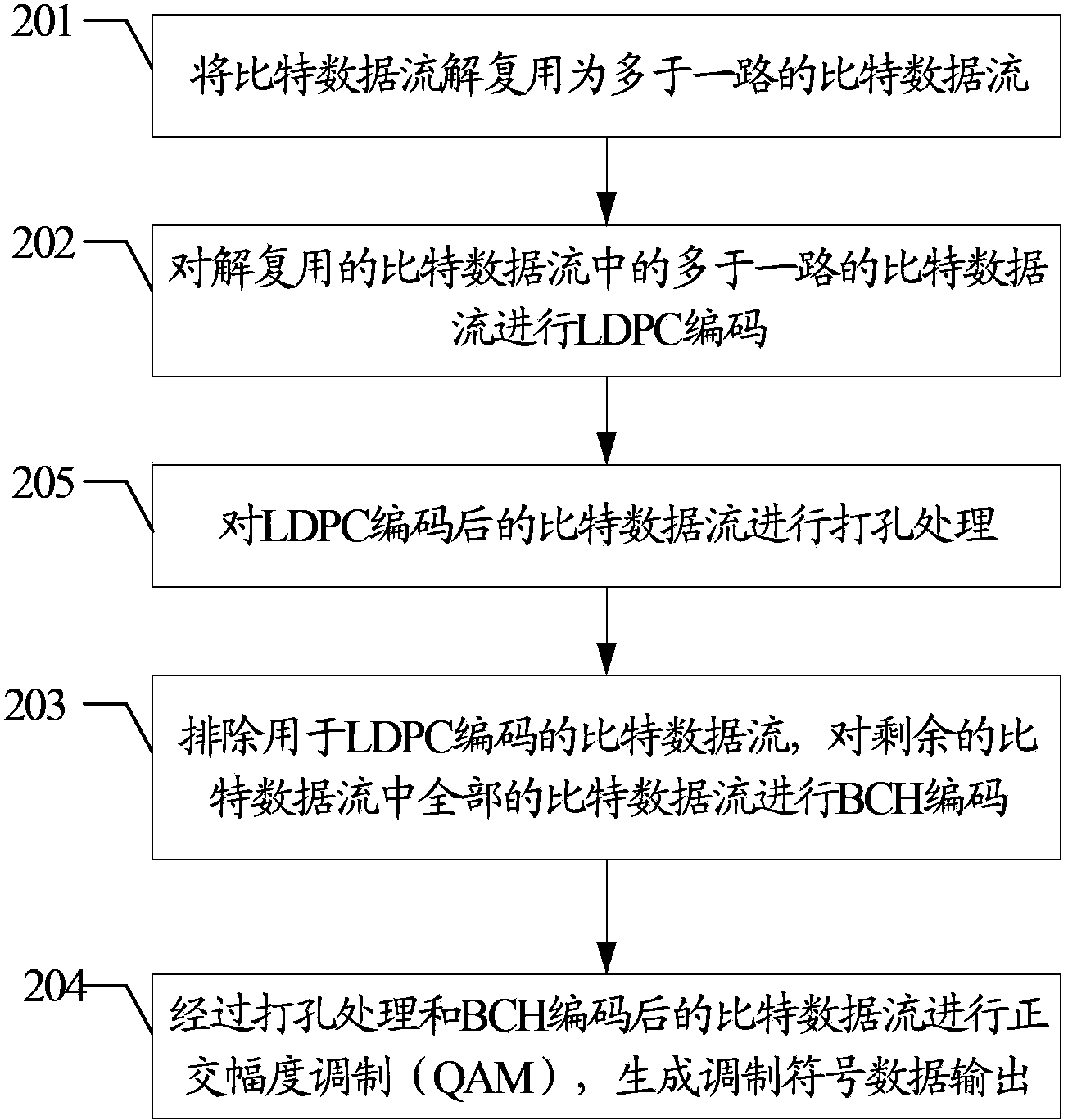Coding modulation method and apparatus for high-order modulation, and decoding method and apparatus for high-order modulation
A high-order modulation and demodulation method technology, applied in the field of communication, can solve problems such as the deterioration of the bit error rate, the impact on system performance, and burst errors, and achieve the improvement of demodulation accuracy, high transmission efficiency, and optimal correction of random or The effect of sudden errors
- Summary
- Abstract
- Description
- Claims
- Application Information
AI Technical Summary
Problems solved by technology
Method used
Image
Examples
Embodiment 1
[0054] An embodiment of the present invention provides a coding and modulation method for high-order modulation in a communication system, and the method is applied to a communication system, such as figure 2 As shown, the method includes:
[0055]Step 101: converting the information to be transmitted into a bit data stream, and demultiplexing the bit data stream into more than one bit data stream;
[0056] Step 102: performing first-type encoding on at least one bit data stream among more than one bit data streams to obtain first output data;
[0057] Wherein, the first type of coding mentioned in step 102 can specifically be low density parity check code (LDPC, Low Density Parity Check) coding, or convolutional coding, or Polar code, or Turbo coding, or generalized Concatenated codes, or product codes, etc., are not exhaustive here, and may also be other advanced high-performance channel coding methods. If LDPC encoding is adopted, and the code rate of the LDPC encoder is...
Embodiment 2
[0070] An embodiment of the present invention provides a coding and modulation method for high-order modulation in a communication system. This method is similar to Embodiment 1, the difference is that in this embodiment, the first type of coding is LDPC coding, and the second type of coding is using LDPC coding. A specific example of BCH encoding. like image 3 As shown, the method includes:
[0071] Step 201: converting the information to be transmitted into a bit data stream, and demultiplexing the bit data stream into more than one bit data stream;
[0072] Step 202: performing LDPC encoding on more than one bit stream in the demultiplexed bit stream;
[0073] Step 203: punching out the LDPC encoded bit data stream;
[0074] Step 204: exclude the bit data streams used for LDPC encoding, and perform BCH encoding on all the bit data streams in the remaining bit data streams;
[0075] Step 205: Quadrature Amplitude Modulation (QAM) is performed on the bit data stream afte...
Embodiment 3
[0082] An embodiment of the present invention provides a coding and modulation method for high-order modulation in a communication system. This method is similar to Embodiment 2 and is applied to a communication system. The difference is that in this embodiment, high-order QAM processing is performed. , including bit streams that have not been type 1 or type 2 encoded. like Figure 5 As shown, in this embodiment, the first type of encoding still uses LDPC encoding as an example, and still includes puncturing processing, and the second type of encoding uses BCH encoding or RS encoding. The N-way bit data stream after the bit data stream is demultiplexed, that is, a 0 to a N , if the code rate of the current LDPC encoder is 3 / 4, then the bit data stream input to the LDPC encoder is 3-way, assuming a 0 to a 2 , output the bit data stream after LDPC encoding, punch the bit data stream after LDPC encoding, and output b 0 to b 3 These 4 bit data streams; a 3 to a 3+x After t...
PUM
 Login to View More
Login to View More Abstract
Description
Claims
Application Information
 Login to View More
Login to View More - R&D
- Intellectual Property
- Life Sciences
- Materials
- Tech Scout
- Unparalleled Data Quality
- Higher Quality Content
- 60% Fewer Hallucinations
Browse by: Latest US Patents, China's latest patents, Technical Efficacy Thesaurus, Application Domain, Technology Topic, Popular Technical Reports.
© 2025 PatSnap. All rights reserved.Legal|Privacy policy|Modern Slavery Act Transparency Statement|Sitemap|About US| Contact US: help@patsnap.com



